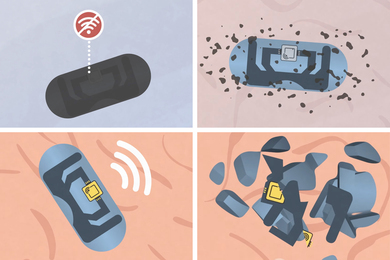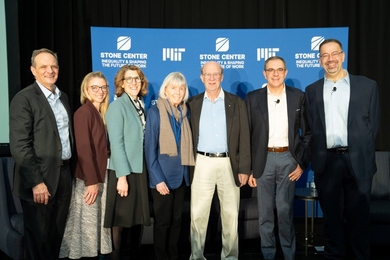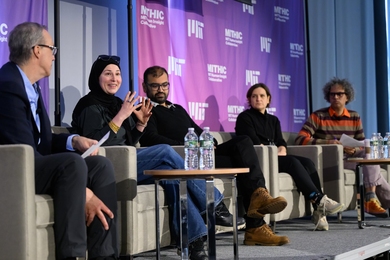The free, open-source Scratch programming language, developed by the Lifelong Kindergarten group at the MIT Media Lab by a team led by Mitchel Resnick, has found great popularity around the world as a way for young people (and adults) to learn about programming by manipulating colorful onscreen modules to create games, slideshows, interactive storybooks and other creative projects. More than a million such projects have been uploaded to the Scratch website for public sharing. But Apple this month, in a decision that immediately stirred controversy, rejected an App (developed independently by a programmer in Canada) that would allow viewing of these projects on iPhones and iPads.
In an interview with MIT News, Resnick shared his thoughts about Apple’s move — and what might happen next.
Q. What is your reaction to the decision by Apple not to allow this Scratch viewer on iPads and iPhones?
A. We on the Scratch team are disappointed at Apple’s decision. Our feeling is that it’s especially important for young people to have the opportunity to design, create and express themselves with new interactive media technologies — not just to view these things, but to create them and interact with them. We think it should be open to as many people as possible, and we’re interested in finding ways for people to design and share interactive media on all types of platforms, not just the iPad and the iPhone. It’s important for all platforms to support these opportunities. Right now, it’s a viewer that was not allowed, but over time we certainly would want to have the opportunity to include the ability to create interactive media on these platforms. From this decision, it would seem like they’re not going to allow that.
Q. Is it purely a matter of Apple’s policies, or are there also technical difficulties in bringing the full Scratch programming system to platforms like smart phones and tablets?
A. Apple doesn't allow languages like Flash or Java, and it doesn't allow apps that interpret or execute code If you want kids to be able to create Scratch projects, there is no technical issue, it’s just Apple’s policies. We’ve done some work on a Flash version of Scratch — it’s not finished, but if Apple decided to allow Flash, we could make a version of Scratch for the iPad.
Q. Have you had any contact with Apple about the company’s decision?
A. I haven’t personally. The specific Scratch viewer — we didn’t create that, it was done independently. The person who created it has had some interaction, and he has informed us about that. Over time, as we move farther along in creating our own versions, we may contact them.
We're working on developing a new generation, which we call Scratch 2.0. We’ve started to get some funding. It will be able to do authoring inside web browsers, so you don’t have to do uploading and downloading [the present version requires users to download the software before creating projects]. We’d certainly prefer to do versions that could run across lots of platforms without needing conversion, so I think any restrictions on all kinds of platforms, not just Apple’s, could influence what we decide [on whether to use Flash or another language to create this version]. Our goal is to have the full range of capabilities of the existing version, plus more. By creating programs online, it allows you to do new things, like having it integrate with social media. For example, the program could react in a particular way when someone writes on my Facebook wall, or it could directly send out a Tweet, or could pull real-time data from the web such as a weather forecast or the latest baseball statistics. There are a variety of new features we expect it could have.
In an interview with MIT News, Resnick shared his thoughts about Apple’s move — and what might happen next.
Q. What is your reaction to the decision by Apple not to allow this Scratch viewer on iPads and iPhones?
A. We on the Scratch team are disappointed at Apple’s decision. Our feeling is that it’s especially important for young people to have the opportunity to design, create and express themselves with new interactive media technologies — not just to view these things, but to create them and interact with them. We think it should be open to as many people as possible, and we’re interested in finding ways for people to design and share interactive media on all types of platforms, not just the iPad and the iPhone. It’s important for all platforms to support these opportunities. Right now, it’s a viewer that was not allowed, but over time we certainly would want to have the opportunity to include the ability to create interactive media on these platforms. From this decision, it would seem like they’re not going to allow that.
Q. Is it purely a matter of Apple’s policies, or are there also technical difficulties in bringing the full Scratch programming system to platforms like smart phones and tablets?
A. Apple doesn't allow languages like Flash or Java, and it doesn't allow apps that interpret or execute code If you want kids to be able to create Scratch projects, there is no technical issue, it’s just Apple’s policies. We’ve done some work on a Flash version of Scratch — it’s not finished, but if Apple decided to allow Flash, we could make a version of Scratch for the iPad.
Q. Have you had any contact with Apple about the company’s decision?
A. I haven’t personally. The specific Scratch viewer — we didn’t create that, it was done independently. The person who created it has had some interaction, and he has informed us about that. Over time, as we move farther along in creating our own versions, we may contact them.
We're working on developing a new generation, which we call Scratch 2.0. We’ve started to get some funding. It will be able to do authoring inside web browsers, so you don’t have to do uploading and downloading [the present version requires users to download the software before creating projects]. We’d certainly prefer to do versions that could run across lots of platforms without needing conversion, so I think any restrictions on all kinds of platforms, not just Apple’s, could influence what we decide [on whether to use Flash or another language to create this version]. Our goal is to have the full range of capabilities of the existing version, plus more. By creating programs online, it allows you to do new things, like having it integrate with social media. For example, the program could react in a particular way when someone writes on my Facebook wall, or it could directly send out a Tweet, or could pull real-time data from the web such as a weather forecast or the latest baseball statistics. There are a variety of new features we expect it could have.






